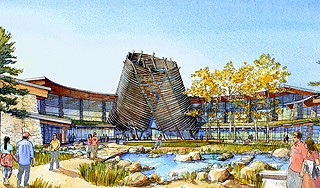|
Subscribe / Renew |
|
|
Contact Us |
|
| ► Subscribe to our Free Weekly Newsletter | |
| home | Welcome, sign in or click here to subscribe. | login |
Architecture & Engineering
| |
August 26, 2008
Southern Ute museum connects with the land
Journal Staff Reporter
The Southern Ute Indian Tribe's new museum was designed to tell the tribe's story in a way that resonates with its members and educates visitors.
Seattle's Jones & Jones Architects and Landscape Architects designed the $35 million museum that will sit on a terrace overlooking the Los Pinos River in Planta County in southwestern Colorado. The groundbreaking was last week and construction is scheduled to be complete in early 2011.
The design for the 51,000-square-foot museum springs from the Southern Ute tribe's connection to the land and way of life, said Bruce Arnold, the project manager. Arnold and principal Johnpaul Jones worked on the museum for five years, holding dozens of meetings with members of the tribe to get direction on the design.
“It has to include the sky because the sky is such an important part of being Ute,” Arnold said. “It has to sit lightly on the land and speak broadly about the landscape.”
The landscape by the museum's entry was designed to capture the look of the Southern Ute's native lands around the Rocky Mountains. All of the plants are native to the region but represent a wide variety of elevations. The museum sits at a lower elevation in the river valley, but landscaping will include trees like spruces and aspens from the highest elevations the tribe used to live in. Willows and cottonwoods from lower elevations, and junipers that are native to the lower valley are also worked into the landscape.
The museum will sit next to a seven-story casino and hotel now in the late stages of construction. The tribe didn't want the casino and hotel space to overshadow the museum, Arnold said, so the museum needed its own iconic look that represented the tribe's core values.
At the building's center is a welcome gallery housed within a large conical form that glows at night. The shape was designed to evoke elements of the Southern Ute way of life, including the wickiup, the tribe's traditional domestic structure, and a tipi, which they lived in later. The inside of the building is designed to look like the head of a tightly pulled drum. The two wings on either side of the welcome gallery have sloped roofs designed after the skyline of the Rockies, where the tribe used to live.
The museum's design also had to include a reference to the circle of life, Arnold said. A circular meadow serves as a gathering place at the entrance. The museum is also designed in the center of a larger circle formed by wings stretching out to the north and south, with landscape filling the remaining space, Arnold said. Visitors travel the space through a central passageway that references the landscape and is meant to give a feeling of circular movement and connection to the land, he said.
“The big idea is that people are reminded that this is a Ute place and the Utes have been here for all time and will continue to be here for all time,” Arnold said.
The site was challenging because of groundwater seepage in the area. The building pad will be elevated a few feet above the grade to protect the building from water damage. Stormwater management was also important to the design, Arnold said. Bioswales and gullies were constructed to manage stormwater movement and drainage, with portions of the parking lot done in gravel. The museum also has a partial green roof.
The use of locally sourced materials was also important to the tribe, Arnold said. Trees skinned of their bark were incorporated into the welcome gallery and passageway. The design also includes stone from southern Colorado, and interior wood and exposed stained and dyed concrete.
“It's important that they see themselves in it and that they can sit inside their ways and beliefs in the museum,” Arnold said. “All this is artifice, it's all design work, but it's all responding to things we were told.”
Jones & Jones was also architect on The National Museum of the American Indian in Washington, D.C., Seattle's Northwest Native Canoe Center and the Agua Caliente Cultural Museum in Palm Springs, Calif.
The Southern Ute team includes: Jones & Jones, architect and landscape architect; West Office Exhibition Design, exhibit designer; Sparling, lighting, electrical, technology and security consultant; Magnusson Klemencic Associates, structural and civil engineer; Stantec, mechanical engineer; Studio SC, signage and graphics; and Bartlett Design, interior designer.
Bids have been received for construction services but a general contractor has not yet been named.
Shawna Gamache can be
reached by email or by phone
at (206) 622-8272.



